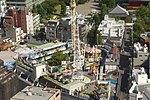Sensō-ji
AsakusaBuddhist temples in TokyoBuildings and structures in Japan destroyed during World War II

Sensō-ji (金龍山浅草寺, Kinryū-zan Sensō-ji) is an ancient Buddhist temple located in Asakusa, Tokyo, Japan. It is Tokyo's oldest temple, and one of its most significant. Formerly associated with the Tendai sect of Buddhism, it became independent after World War II. Adjacent to the temple is a five-story pagoda, the Asakusa Shinto shrine, as well as many shops with traditional goods in the Nakamise-dōri.The Sensoji Kannon temple is dedicated to Kannon Bosatsu, the Bodhisattva of compassion, and is the most widely visited spiritual site in the world with over 30 million visitors annually.The temple has a titanium tiled roof that maintains the historic image but is stronger and lighter.
Excerpt from the Wikipedia article Sensō-ji (License: CC BY-SA 3.0, Authors, Images).Sensō-ji
花やしき通り, Taito Asakusa
Geographical coordinates (GPS) Address Phone number Website External links Nearby Places Show on map
Geographical coordinates (GPS)
| Latitude | Longitude |
|---|---|
| N 35.714722 ° | E 139.79675 ° |
Address
金龍山 浅草寺
花やしき通り 1
111-0032 Taito, Asakusa
Japan
Open on Google Maps










